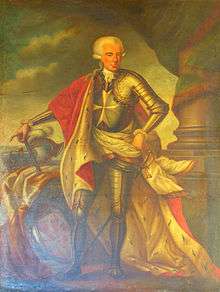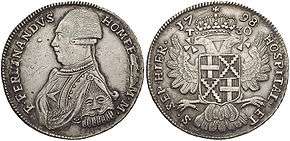Ferdinand von Hompesch zu Bolheim
| His Most Eminent Highness, Fra Ferdinand von Hompesch zu Bolheim, O.S.I. | |
|---|---|
 | |
| Grand Master of the Knights Hospitaller | |
|
In office 17 July 1797 – 6 July 1799 | |
| Preceded by | Emmanuel de Rohan-Polduc |
| Succeeded by | Paul I of Russia (de facto) |
| Personal details | |
| Born |
9 November 1744 Bolheim, Electorate of Cologne, Holy Roman Empire |
| Died |
12 May 1805 (aged 60) Montpellier, Hérault, First French Empire |
| Resting place | Montpellier, Hérault, France |
| Nationality | German |
| Military service | |
| Allegiance |
|
| Years of service | 1761–1799 |
| Rank | Grandmaster |
| Battles/wars | Capture of Malta (1798) |
Ferdinand von Hompesch zu Bolheim, O.S.I. (November 9, 1744 – May 12, 1805) was the 71st Grand Master of the Knights Hospitaller, formally the Order of St. John of Jerusalem, by then better known as the Knights of Malta, being the first German to be elected to the office. It was under his rule that the Order lost their island home to France, after ruling there since 1530. This effectively marked the end of their sovereignty over an independent state, dating from the time of the Crusades.
Life
Early career
Hompesch was born in the village of Bolheim, now part of the town of Zülpich in the Eifel region. He received the baptismal names of Ferdinand Joseph Antoine Herman Louis. He was admitted to the Knights Hospitaller on 10 July 1761, at the age of 14, for which he needed to obtain a dispensation from the Holy See, serving as a page to the Grand Master Manuel Pinto da Fonseca.[1] By 1768 he had been promoted to the rank of castellan, and in 1770 he had advanced to the rank of lieutenant, responsible for the inspection of ships and fortifications of the Order. In 1774 he was given responsibility for the island's munitions.
In late 1775 Hompesch was appointed as the Order's ambassador at the court of the Holy Roman Emperor in Vienna, a post he held for the next 25 years. The following year, he was also raised to the rank of a holder of the Great Cross, making him a member of the Standing Council of the Order. During this period, he made efforts to unite the Protestant branch of the Order which had developed in Germany with the Catholic Order, which fell through due to the opposition of the German knights. In the following years, he received charge of the commandery in Rothenburg (1777), followed by those in Herford (1783), Basel and Dorlisheim—where their Chateau Saint Jean is now the headquarters of Bugatti Automobiles (1785), Sulz, Colmar and Mülhausen (1786) as well as Villingen, in the Black Forest (1796).[2] He was appointed Grand Bailiff of the German "tongue", based in Brandenburg, in 1796.[1]

On 17 July 1797 Hompesch was elected Grand Master, which made him a Prince of the Church. As Grand Master, he raised the towns of Żabbar, Żejtun and Siġġiewi to the status of cities.
Loss of Malta
In 1798 Hompesch was warned that the French fleet that was sailing to Egypt under Napoleon Bonaparte intended to attack Malta as well. He disregarded the warning and took no action to reinforce the island's defenses.[3] On 6 June 1798, the advance squadron of the French fleet reached Malta. One ship was permitted to enter the harbour for repairs. On June 9 the main fleet arrived. The French commander Napoleon had a force of 29,000 men against Hompesch's 7,000. Bonaparte demanded free entrance to the harbour for the entire fleet with the excuse to get water provisions. Hompesch replied that only two ships at a time could do so. Napoleon saw it as a provocation and ordered the invasion of the Maltese Islands.

On 10 June the French fleet began disembarking.[4] The French forces were supported by a local insurrection of Maltese, many of whom wished to get rid of the Knights.[5] The rules of the Order prohibited fighting against fellow Christians and many of the French members of the Order did not want to fight against the French forces. Hompesch capitulated on 11 June. The following day a treaty was signed by which the Order handed over sovereignty of the island of Malta to the government of the French Directory. In return, the French Republic agreed to "employ all its credit at the Congress of Rastatt to procure a principality for the Grand Master, equivalent to the one he gives up".[6] Hompesch was also promised an annual pension.
Final years
Hompesch left Malta for Trieste on 18 June,[7] where he established a new headquarters for the Order. He resigned as Grand Master on 6 July 1799, and soon settled in Ljubljana. In 1804 he moved to Montpellier in France, where he died penniless one year later of asthma.[8] He is buried in the Church of Saint Eulalie in that city.[9]
Notes
- 1 2 Whitworth Porter, A History of the Knights of Malta (London: Longman, Brown, Green, 1858), v.2, 438.
- ↑ Galea, Michael (24 July 2011). "A hamlet called Hompesch". Times of Malta. Retrieved 11 October 2014.
- ↑ Porter, 443-444.
- ↑ Porter, 445.
- ↑ Porter, 447.
- ↑ Porter, 451.
- ↑ Porter, 457.
- ↑ Porter, 460.
- ↑ "200° anniversary of the death of Grand Master von Hompesch". Order of Malta. 10 May 2005. Retrieved 11 October 2014.
Further reading
- Galea, Michael. Ferdinand von Hompesch, a German Grandmaster in Malta: A Monograph. Malta: Deutsche Gemeinde, 1976. There is an expanded version in German by Joseph A. Ebe, entitled Ferdinand Freiherr von Hompesch, 1744-1805: letzter Grossmeister des Johanniterordens/Malteserordens auf Malta (Paderborn: Melitensia, 1985, ISBN 3-9801071-1-6).
- Hompesch and Malta: A New Evaluation, edited by Maurice Eminyan. San Gwann, Malta: Enterprises Group, 1999. ISBN 99909-0-237-2.
- Ferdinand von Hompesch, der letzte Grossmeister auf Malta: Ausstellung im Maltesermuseum Mailberg. Mailberg: Arbeitsgemeinschaft Maltesermuseum Mailberg, 1985.
External links
| Preceded by Emmanuel de Rohan-Polduc |
Grand Master of the Knights Hospitaller 1797–1799 |
Succeeded by Paul I of Russia de facto |